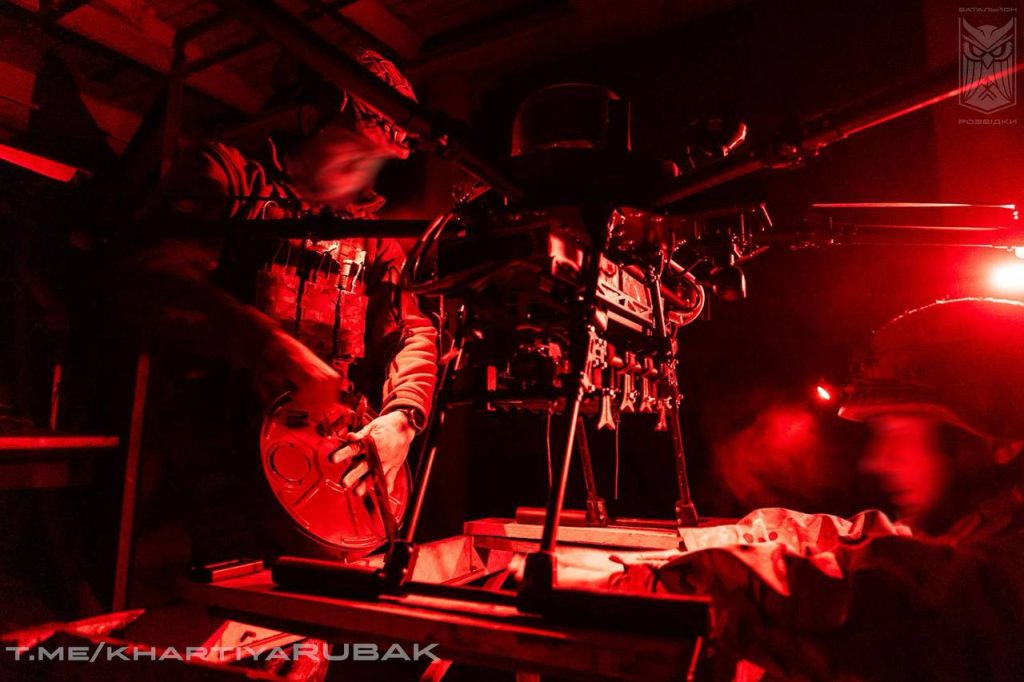Russia’s drone barriers aim to protect logistics routes
Russian engineers are erecting kilometres of net screens and tunnels along the roads leading to the frontlines in Ukraine in a bid to protect their soldiers from Ukrainian drone strikes, according to a 17th March article published by Izvestia. You can see an example of some of these nets in the selection of posts on X.com below.
ru worms anti drone nets pic.twitter.com/thkC7Q2tQM
— IgorGirkin (@GirkinGirkin) March 3, 2025
The first reports of net tunnels appeared in early February, indicating several kilometres of netting between Chasiv Yar and Bakhmut, which appears to have been the area visited by the reporter from Izvestia. There, groups of engineers emplace metal or wooden poles by the side of the roads, some 15 metres in height. A metal wire is strung between the poles and used to hang netting, establishing a corridor for vehicles to safely travel through.
Depending on the surrounding terrain and features, the netting takes the form of either high walls or a tunnel. Each unit is experimenting with different types of netting, with earlier videos showing a much thicker net with smaller holes. Those nets shown in the Izvestia report appear to be made of thin fishing line with comparatively large openings. “You saw that it is poorly visible on the phone camera, respectively, it is even worse [sic] visible on the drone camera. The operator may not notice it and get confused,” one of the engineers told Izvestia.
The process requires the engineers to clear the sides of the roads of mines and explosives first, given that the region was heavily fought over in the “Bakhmut meat grinder.” The process appears to take some time and is divided amongst different groups of engineers. They work at different times to try and prevent their movements from being predicted. Once the net is established, the engineers transfer to a maintenance schedule, repairing the nets when damaged by Ukraine’s drones.
“You have to be a very competent drone operator to find a way to duck under a net and fly low along a road. And there aren’t many of those,” one of the soldiers said, indicating that, like all solutions, the nets are not perfect.
Drone barriers and battlefield geography
The tunnels have become important because of the way that the frontlines are set up in Ukraine. The zero line, where the fighting happens, is some distance – potentially tens of kilometres – from where the units spend much of their time. They will rotate into frontline positions every three to four days, depending on the level or organisation and available troops.
This requires them to drive forward, running through a gauntlet of Ukrainian drones. Ukrainian forces are aware of this, and so focus much of their attention on the area leading to the frontline positions, aiming to intercept logistics and supply, as well as troop rotations.
One Russian blogger noted that Ukrainian drones, including FPVs and the Baba Yaga bomber drones, can reach up to 20 km behind the frontline. They mine roads and bomb vehicles trying to move along them, with the goal of isolating the frontline.
It is worth noting that both sides are using this tactic; the Russian forces fighting to take Bakhmut worked to bring the supply route under fire, and the pressure on Ukrainian supplies into the Kursk salient was a significant element in Ukraine’s decision to withdraw. “The core problem was logistics as Russian fiber-optic FPV drones increasingly interdicted resupply routes,” Mike Kofman, a Senior Fellow at the Carnegie Endowment said on X.com on March 20th.
If the supplies to the front can be intercepted and disrupted on a regular enough basis, it will become more difficult for the soldiers holding the front – who typically are few in number – to resist any advances.
Drone strikes are combined with extensive mining and conventional artillery fires, with the result that, “Russian units often don’t reach defensive positions and much of the equipment is lost in assaults,” according to Kofman. This was a deliberate tactic picked by the Armed Forces of Ukraine last year, leading to the increase in drone and mine production, he adds.
Watching the skies

Ukraine uses heavy drones like the Vampire shown here to lay mines along routes used by Russian forces, driving the need for drone barriers. Credit: Ukrainian MoD.
‘Drone busters’ accompany the engineering teams, armed with shotguns and assault rifles with sights as well as drone detectors. They are expected to provide protection against FPVs and drones if they are sent to engage the engineering parties.
There are drone detectors throughout the area, and each checkpoint passed provides an indication of the drone threat. Green indicates everything is relatively clear, yellow that the ‘drone busters’ should be ready, and red that only those personnel with combat missions that cannot be delayed can proceed, Izvestia states.
When a drone is detected, vehicles are driven into hides and electronic warfare (EW) systems activated. The drone busters are stationed ready to intercept those that are not degraded by the EW, or fibre-optic drones that are immune to jamming.
Shotguns appear to be at least a part of an effective counter-drone solution, they are widely used by Russian and Ukrainian units. British forces in Afghanistan would regularly have one soldier armed with a primary weapon – his assault rifle – and a shotgun as a secondary armament. This indicates that shotguns could serve as an appropriate last layer of defence, potentially with improved ammunition.
Calibre comment
As a result of Ukraine’s tactics, Russian units have struggled to achieve any operationally significant breakthroughs, and have suffered heavy losses in equipment and personnel. They have focused on small unit tactics and advances designed to shape the frontline by incrementally seizing ground. The inability to mass formations because they are frequently intercepted and destroyed on their way to the frontline, is partly responsible for this. If Russian forces can reduce the effects of Ukraine’s drone-based deep strikes through applying netting to a far greater extent of the rear echelon road network, then it would shift more of the onus onto fighting Russian units as they emerge from the protected areas.
Or, it could lead to a far greater focus on the use of conventional artillery, which is unlikely to be impacted by the netting. That is, of course, if the netting provides a reliable counter-measure to Ukraine’s FPVs and bomber drones. Another alternative might be the evolution of new types of drones to cut or burn holes through the netting, facilitating access for strike drones to then seek out targets within the tunnel.

Sign Up for Updates!
Get insider news, tips, and updates. No spam, just the good stuff!





